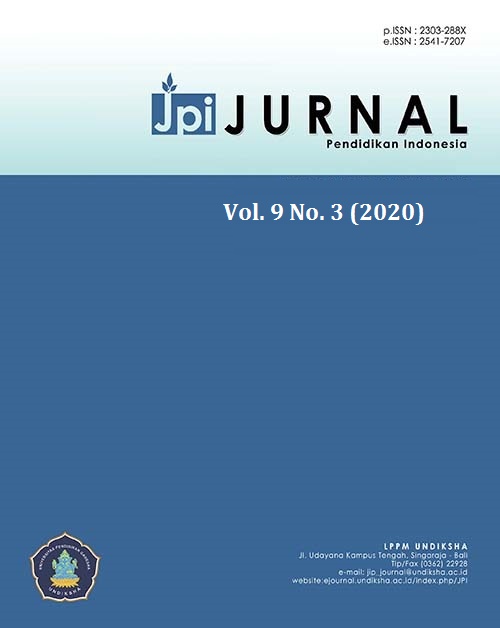Reproductive Health Animations as Efforts to Prevent Sexual Harassment in Deaf Students
DOI:
https://doi.org/10.23887/jpi-undiksha.v9i3.24916Keywords:
Sex EducationAbstract
This research aims to obtain information about the needs of developing reproductive health animation media to prevent sexual harassment and deviation in deaf students. The research was conducted at 14 school of special in Jakarta and West-Java Province with quantitative method. Data was taken from 105 teachers through a questionnaire and analyzed using Huberman and Miles models and the process including data reduction, data display, and verification. The results of this research obtain communication barriers which are the main cause of the ineffectiveness of sex education in deaf students can be overcome by developing reproductive health media for deaf students. So, it can be concluded that learning of reproductive health for deaf students provide a good understanding of sex education in reproductive health.
References
Cahyani, Y. N., Verdiantoro, A. G., & Uma, F. (2020). Perlindungan Hukum Bagi Korban Tindak Kekerasan Seksual Kaum Tunarungu Dalam Perspektif Hukum Pidana. Mimbar Keadilan, 13(2), 218–228. https://doi.org/10.30996/mk.v13i2.3941
Cheung, C., Baum, T., & Hsueh, A. (2018). Workplace sexual harassment: exploring the experience of tour leaders in an Asian context. Current Issues in Tourism, 21(13), 1468–1485. https://doi.org/10.1080/13683500.2017.1281235
Çuhadaroğlu, A. (2017). The effects of sex education on psychological counselling students in Turkey. Sex Education, 17(2), 209–219. https://doi.org/10.1080/14681811.2016.1164132
Farakhiyah, R., Raharjo, S. T., & Apsari, N. C. (2018). Perilaku Seksual Remaja Dengan Disabilitas Mental. Share : Social Work Journal, 8(1), 114–126. https://doi.org/10.24198/share.v8i1.18122
Findley, P. A., Plummer, S. B., & McMahon, S. (2015). Exploring the Experiences of Abuse of College Students With Disabilities. Journal of Interpersonal Violence, 1–23. https://doi.org/10.1177/0886260515581906
Hilmi, M. F. (2019). Kekerasan Seksual dalam Hukum Internasional. Jurist-Diction, 2(6), 2199–2218.http://dx.doi.org/10.20473/jd.v2i6.15949
Imawati, Y., & Chamidah, A. N. (2018). Efektivitas media berbasis augmented reality terhadap kemampuan anak tunarungu mengenal kebudayaan Yogyakarta. JPK (Jurnal Pendidikan Khusus), 14(1), 26–34. https://doi.org/10.21831/jpk.v14i1.25164
Jones, C., Stalker, K., Franklin, A., Fry, D., Cameron, A., & Taylor, J. (2017). Enablers of help-seeking for deaf and disabled children following abuse and barriers to protection: a qualitative study. Child and Family Social Work, 22(2), 762–771. https://doi.org/10.1111/cfs.12293
Leung, H., Shek, D. T. L., Leung, E., & Shek, E. Y. W. (2019). Development of Contextually-relevant Sexuality Education: Lessons from a Comprehensive Review of Adolescent Sexuality Education Across Cultures. International Journal of Environmental Research and Health, 16(4). https://doi.org/10.3390/ijerph16040621
Lucarini, A., Suitner, C., Brown, R., Craig, M. A., Knowles, E. D., & Salvador Casara, B. G. (2020). The #MeTooLate Effect: Victim blame and trust denial for sexual harassment not immediately reported. Personality and Individual Differences, 167(July), 110240. https://doi.org/10.1016/j.paid.2020.110240
Margarita, L., & Wahyuno, E. (2014). Penggunaan Media Animasi Macromedia Flash Untuk Meningkatkan Kualitas Pembelajaran Ipa Siswa Tunarungu Kelas Ii Sdlb. Jurnal Penelitian Dan Pengembangan Pendidikan Luar Biasa, 1(2), 137–139. http://journal2.um.ac.id/index.php/jppplb/article/view/4314
McDaniels, B., & Fleming, A. (2016). Sexuality Education and Intellectual Disability: Time to Address the Challenge. Sexuality and Disability, 34(2), 215–225. https://doi.org/10.1007/s11195-016-9427-y
Mcdonald, P., & Charlesworth, S. (2016). Workplace sexual harassment at the margins. Work, Employment & Society, 30(1), 118–134. https://doi.org/10.1177/0950017014564615
Putriningsih, N., & Stanislaus, S. (2012). Intensi Pekerja Rumah Tangga Korban Pelecehan Seksual Untuk Melapor. Intuisi : Jurnal Psikologi Ilmiah, 4(3), 123–128. https://doi.org/10.15294/intuisi.v4i3.13344
Raj, A., Freund, K. M., McDonald, J. M., & Carr, P. L. (2020). Effects of sexual harassment on advancement of women in academic medicine: A multi-institutional longitudinal study. EClinicalMedicine, 20, 100298. https://doi.org/10.1016/j.eclinm.2020.100298
Ramdhani, I. (2017). Kasus Pelecehan Seksual Dalam Transportasi Umum Menurut Putusan Pengadilan Negeri Jakarta Pusat. SALAM: Jurnal Sosial Dan Budaya Syar-I, 4(1), 95–120. https://doi.org/10.15408/sjsbs.v4i1.7871
Romulo, H. M., Akbar, S. N., & Mayangsari, M. D. (2016). Peranan Pengetahuan Kesehatan Reproduksi Terhadap Perilaku Seksual Remaja Awal. Jurnal Kesehatan Andalas, 1(4). https://doi.org/10.20527/ecopsy.v1i4.504
Rusinga, O. (2012). Perceptions of deaf youth about their vulnerability to sexual and reproductive health problems in Masvingo District, Zimbabwe. African Journal of Reproductive Health, 16(2), 271–282. https://www.ajol.info/index.php/ajrh/article/view/77854
Suharti, S., & Daryono, D. (2020). Efektifitas Video Berdialek Bahasa Jambi untuk Meningkatkan Pengetahuan tentang Penyakit HIV/AIDS pada Remaja di SMAN 8 Kabupaten Muaro Jambi. Jurnal Ilmiah Universitas Batanghari Jambi, 20(2), 418–423. https://doi.org/10.33087/jiubj.v20i2.953
Suwandi, J., Chusniatun, C., & Kuswardani, K. (2019). Karakteristik Kekerasan Seksual Terhadap Anak Perempuan Di Wonogiri Dan Boyolali. Jurnal Pendidikan Ilmu Sosial, 29(1), 65–77. https://doi.org/10.23917/jpis.v29i1.8285
Widinarsih, D. (2019). Penyandang Disabilitas di Indonesia: Perkembangan Istilah dan Definisi. Jurnal Ilmu Kesejahteraan Sosial, 20(2), 127–142. http://jurnalkesos.ui.ac.id/index.php/jiks/article/view/239
Windasari, N. (2020). Karakteristik Kasus Kekerasan Seksual di Rumah Sakit Tipe A di Jawa Barat dan Sumatera Barat. Jurnal Kesehatan Andalas, 9(2), 218–224. https://doi.org/10.25077/jka.v9i2.1308
Yasin, M. H. M., Tahar, M. M., Bari, S., & Manaf, F. N. (2017). The Sign Language Learning in Deaf Student and Special Education Teacher in Integration Program of Hearing Problem. Journal of ICSAR, 1(2), 166–174. https://doi.org/http://dx.doi.org/10.17977/um005v1i22017p166
Downloads
Published
Issue
Section
License
Authors who publish with the Jurnal Pendidikan Indnesia agree to the following terms:
- Authors retain copyright and grant the journal the right of first publication with the work simultaneously licensed under a Creative Commons Attribution License (CC BY-SA 4.0) that allows others to share the work with an acknowledgment of the work's authorship and initial publication in this journal.
- Authors are able to enter into separate, additional contractual arrangements for the non-exclusive distribution of the journal's published version of the work (e.g., post it to an institutional repository or publish it in a book), with an acknowledgment of its initial publication in this journal.
- Authors are permitted and encouraged to post their work online (e.g., in institutional repositories or on their website) prior to and during the submission process, as it can lead to productive exchanges, as well as earlier and greater citation of published work. (See The Effect of Open Access)








